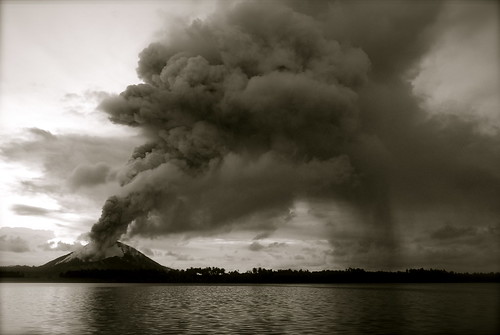Sorry about the dearth of posts. It has been a busy week here in Davis and I've been a little distracted by the upcoming election. Combined with the relative lack of volcano news this week, the posting has been lackluster.
However, that being said, I will try to make up for some of it by starting my Volcano Profiles series that will bide the time between volcano news. I start with a volcano that was suggested by Eruptions reader Thomas Donlon: Rabaul.
VOLCANO PROFILE: RABAUL

Â
- Location:Â Papau New Guinea
- Height: 688 m
- Geophysical location:Â Boundary of Australian plate and Pacific plate, where the Pacific plate is subducting under the Australia (note: very simplified as there are a number of microplates involved as well).
- Type:Â Arc-related caldera
- Monitoring: Rabaul Volcano Observatory
- Summary:Â Rabaul is an 8x14 km caldera that has been partially filled by the sea, but multiple peripheral vents can been seen along the caldera edges. Likely the caldera seen today was formed 1,400 years ago and there is evidence that an ancestral caldera formed 7,100 years ago. The volcanic system erupts basaltic through dacitic lavas from these vents, producing lava flows and voluminous pyroclastic flows that have caused extensive death and damage to the settlements near the caldera over the last 200 years. The currently active vents are Tavurvur and Vulcan.
- Current status:Â The Rabaul caldera is currently in an active cycle which started in 1994, producing ash and steam eruptions, along with lava flows and ash flows from both Tavurvur and Vulcan. The caldera has been constantly active since 2006, with the most recent activity consisting of earthquake and small, conduit-clearing eruptions from a shallow reservoir.

- Notable Recent Eruptions: The Rabaul Caldera has had two major eruptions in the past 100 years and they are stark contrasts in terms of hazard mitigation and evacuation. The eruptions from Vulcan and Tavurvur in 1937 killed more than 500 people while blanketing the countryside in ash. It also produced a tsunami that washed boats onshore. This eruption is thought to have been roughly a VEI 4. Vulcan and Tavurvur followed up this eruption with another VEI ~4 in 1994, but thanks to excellent planning, evacuating practice and an organized response, the death toll to this eruption was a mere 5 (an excellent summary of this evacuation was presented on an episode of NOVA). This eruption produced ash fall and pyroclastic flows from at least 5 vents along the caldera and the ash fall effects were amplified by heavy rain (likely caused by the eruption itself). Some of this ash was in excess of 7 feet and destroyed 80% of the structures in the town of Rabaul. Interestingly, the only real signs of a potential eruption at the Rabaul Caldera before 1994 was significant surface uplift in the caldera in the mid-1980s, followed by quiescence until the 1994 eruption.
I am trying to find out information about my great grandfather. He was apparently working on board a ship in Rabaul that was sucked out to sea and never found, during a Tsunami in 1903. Do you have any information about a tsunami at or about this time?
Thank You
Greg Buist
Any info on the 1400ya event? I read somewhere that it was massive and casued a global cooling event.
Thank you very much for your help, I am doing an assignment on Tavurvur and this has been great!
@1 Greg Buist, Hey Greg, here is a paper that will just about tell you everything. While it does talk about Rabaul it also compares it to other similar eruptions while describing Tsunami's.
http://vulcan.wr.usgs.gov/Projects/Mastin/Publications/JVGR-2000/JVGR_l…